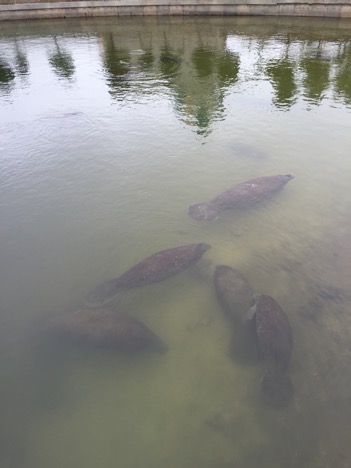By Lauren Schroeder | gargoyle@flagler.edu
Each year in Florida, manatees are dying from cold stress syndrome due cold winter water temperatures.

Manatees migrate to Apollo Beach during winter months in search of warmer waters.
In Apollo Beach this year, “35 died from cold stress syndrome due to the cold snap here in Florida from Jan. 1 to the 25,” said Jasmine McComber, a worker at the Manatee Viewing Center in Apollo Beach.
Cold stress syndrome is a common illness among manatees that occurs when they are exposed to cold temperatures for a long period of time. In fact, manatees are unable to withstand temperatures below 20 degrees celsius, according to Julie Hughes, director of Sea to Shore Alliance.
“White sores will form on their skin due to vasoconstriction of blood to their skin and extremities, causing tissues to die and eventually get infected. They will venture out to feed less and will become dehydrated. They can succumb to the syndrome due to starvation, dehydration, infection or all of the above,” said Hughes.
Though the appearance of these massive sea cows may be deceiving, they lack the proper insulation that would allow for them to be in cold waters.
“The Florida manatee relies on warm water for survival throughout the winter, often succumbing to disease or death when these habitats are unavailable. Manatees do not have blubber like other marine mammals. Their fat is more like our fat and is not a good insulator,” Hughes said.
Though some manatees fall ill to cold stress syndrome during winter months, most have migration patterns they follow every year to prevent getting trapped in cold waters.
“They either learn from their mothers while they are calves, follow other manatees to learn new locations, or explore on their own to find additional locations,” Hughes said.
One of the popular locations for manatees to migrate in Florida is Apollo Beach where the Big Bend Power Station is located. Since the power station is located along the water, the heat released warms the water, making it a perfect location for manatees to migrate.
In fact, according to Jasmine McComber, hundreds of manatees come to this location every year.
“In 2017 we had 527 manatees, in 2016 we had 773, 2015 we had 556 and 2011 was 632,” McComber said.
Once the water gets cold, the manatees migrate to Apollo Beach and stay there until around April when the water finally warms up.
While most manatees follow the same migration patterns every winter, some are unable to do so.
“A very large majority do [migrate] but there are some large calves or small juveniles that do not remember and may resulting in getting rescued for cold stress or die from the cold water.”
To prevent this from occurring, Sea to Shore Alliance, a non-governmental organization tags the manatees in order to track them.
“Manatees are fitted with a satellite-linked GPS tag assembly using a specially designed breakaway padded belt that wraps around the peduncle portion of the manatee (just above the tail) and has a breakaway tether that attaches to the tag,” Hughes said. “Free-tagging is performed by swimming up to the manatee and slipping the belt over the tail or head region of the manatee and tightening the belt to a loose fit around the peduncle.”
Once the manatee is tagged, it is tracked daily by the satellite and GPS tags.
“Tags are programmed to attempt GPS fixes every 15 minutes and relay GPS locations and sensor data (e.g., tag activity and diving behavior) to our computers through the Argos satellite system in near-real-time,” Hughes said.
By tagging the manatees, Sea to Shore Alliance is able to track them and also see if they are showing signs of cold stress.
“Our role is to provide the outpatient care: monitoring through satellite telemetry and regular monitoring of manatees released into the wild to ensure their survival. If one of our tagged manatees is showing signs of cold stress or not in adequate habitat for survival, we work with FWC to rescue the individual,” Hughes said.
The good news is that most of the manatees rescued that have cold stress syndrome are able to fully recover if treatment is given timely by critical care facilities.
Sea to Shore Alliance tries to track the manatee for a year, however, they typically are tracked for four to six months. This is due to the tracking equipment that is designed to come off if a tag is entangled on a dock or underwater debris.
Tracking also has other helpful uses for the manatees besides aiding their rescue when trapped in cold water.
“Ultimately, tracking data will provide insight into habitat use which our team will provide to resource managers for future protection measures. It is vital to identify and understand the habitat manatees need for survival, Hughes” said.
Since every year manatees fall ill to cold stress syndrome, the hope is that tracking can help reduce this from occurring in the future.



Be the first to comment on "Manatee deaths stemming from frigid waters"